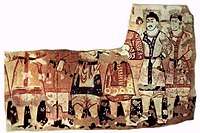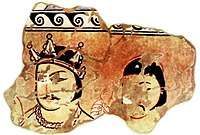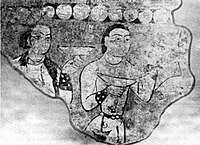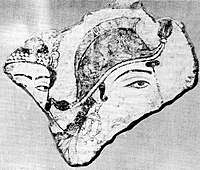Dilberjin
Dilbarjin (Delbarjin, Dilberjin) is the modern name for the remains of an ancient town in modern (northern) Afghanistan. The town was perhaps founded in the time of the Achaemenid Empire. Under the Kushan Empire it became a major local centre. After the Indo-Sassanids the town was abandoned.


Archaeological remains
The town proper was about 390 x 390 m large. Dilbarjin had a city wall built under the Kushan rule. In the middle of the town there was a round citadel, built at about the same time. In the North-East corner of the town was excavated a temple complex. Here were found many wall paintings, some in a purely Hellenistic style. Originally the temple was perhaps dedicated to the Dioscuri, of which a mural in Hellenistic style has been recovered.[1] A mural shows a row of warriors in kaftan, relatively similar to the mural from Kyzyl, and datable to the 5th-6th century CE.[2]
A much later frescoe showing an Indian scene, with Shiva and Parvati on the bull Nandi, has been dated to the 8th century CE.[3][4]
A long inscription in the Kushan language was also discovered, dated to the early great Kushans, around the period of Kanishka I, on paleographic grounds, as it seems slightly younger than the inscription of Surkh Kotal.[5]
Coins of the Kushano-Sasanians and the Kidarites were the most numerous from the early Sasanian period to have been found on the site.[6] About 72 such coins were found, belonging to Ardashir I, Peroz I, Hormiz I, as well as each type of the Varahran I, that is, the coins first struck under Varahran, and then those struck on the model of Varahran by the Kidarite rulers Kirada, Peroz and Kidara I.[6][7]
Outside the city walls there were still substantial buildings. Finds include inscriptions in Bactrian, most of them too destroyed to provide any historical information. There were fragments of sculpture and many coins.
References
- Muzio, Ciro Lo. The Dioscuri at Dilberjin (Northern Afghanistan): Reviewing their Chronology and Significance. pp. 43, page 67 Fig.1.
- Dani, Ahmad Hasan; Litvinsky, B. A. (1996). History of Civilizations of Central Asia: The crossroads of civilizations, A.D. 250 to 750. UNESCO. p. 151. ISBN 978-92-3-103211-0.
- Pugachenkova, G.A. Kushan Art (PDF). p. 331 Fig. 9.
- Muzio, Ciro Lo. The Dioscuri at Dilberjin (Northern Afghanistan): Reviewing their Chronology and Significance. pp. 59, drawing in Page 71 Fig 17.
- "Les fouilles de la mission archéologique soviéto-afghane sur le site gréco-kushan de Dilberdjin en Bactriane" (PDF). Compte-rendus de l'Académie des Inscriptions et Belles Lettres: 412, Fig.7. 1977.
- Cribb, Joe. The Kidarites, the numismatic evidence.pdf (PDF). p. 107.
- Cribb, Joe. The Kidarites, the numismatic evidence.pdf (PDF). pp. 91–146.
- "Les fouilles de la mission archéologique soviéto-afghane sur le site gréco-kushan de Dilberdjin en Bactriane" (PDF). Compte-rendus de l'Académie des Inscriptions et Belles Lettres: 407–427. 1977.
- Dani, Ahmad Hasan; Litvinsky, B. A. (1996). History of Civilizations of Central Asia: The crossroads of civilizations, A.D. 250 to 750. UNESCO. p. 151. ISBN 978-92-3-103211-0.
- Pugachenkova, G.A. Kushan Art (PDF). p. 331 Fig. 9.
- Muzio, Ciro Lo. The Dioscuri at Dilberjin (Northern Afghanistan): Reviewing their Chronology and Significance. pp. 59, drawing in Page 71 Fig 17.
Literature
- Warwick Ball: Archaeological Gazetteer of Afghanistan : Catalogue des sites archéologiques d'Afghanistan, Paris 1982, p. 91-92

_I_Balkh_mint_Struck_under_Kidarite_king_Kidara_circa_CE_350-365.jpg)



.jpg)




